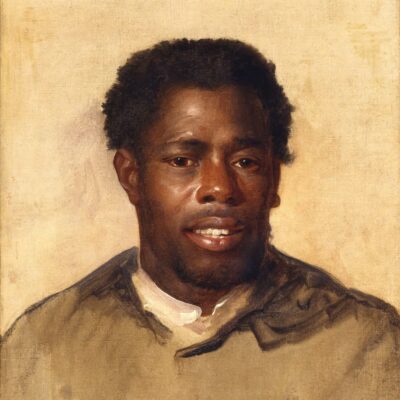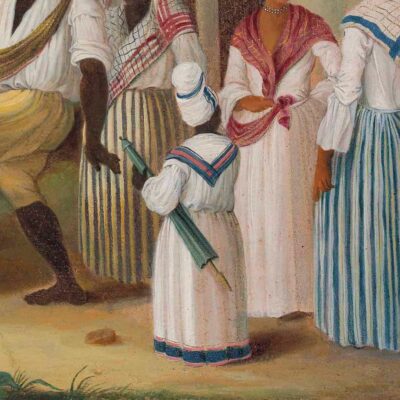Why Judicial Testimony?
Understanding why judicial testimony gives us access to the voices of the enslaved
Slave Codes, Court Procedure, and Testimony
IntroductionIn eighteenth-century New Orleans, the legal testimony of some 150 enslaved men and women—like the testimony of free colonists—was meticulously written down and preserved. It is important to understand how and why this archival record, from which this project is derived, was created. In most North American English colonies, the enslaved were prohibited from testifying at all, and in those instances where they could, their words were not always carefully taken down. In French Louisiana, the enslaved could in some circumstances testify, and when they did, their words were systematically transcribed and entered into the court record. The existence of enslaved testimony from colonial Louisiana is owing to the combination of French judicial procedures with French colonial slave codes, which not only regulated access to testimony but explain how and why testimony was recorded. French court procedure also structured how slave trials were conducted. As in France, trials were inquisitorial, held in courts that were not open to the public, and decided by judges, not juries. In addition, in Louisiana, there were no lawyers. Although the enslaved were tried in the same spaces as colonists, justice was not blind, for slave laws—and how laws were applied—ensured that the enslaved were prosecuted and sentenced in disproportionate numbers compared to colonists, while having fewer rights.1Legal Frameworks
Legal FrameworksBroadly speaking, court procedure in Louisiana adhered to the rules laid out in France’s 1670 Code criminel, which regulated criminal matters (civil matters were governed by the Coutume de Paris). For the enslaved, access to testimony was a function of slave codes. These laws determined whether they could testify, in what circumstances, and in what capacity.2
The French crown issued a slave code for Louisiana in 1724. Before then, the colony was governed by the 1685 code noir written for the French Caribbean islands. Drafted by the governor and intendant in Martinique, the 1685 code was founded on local jurisprudence with only minimal revisions made by authorities in France. In contrast, Louisiana’s 1724 code noir was imposed from France. It was virtually identical, word for word, to the 1723 code noir pertaining to African slavery in France’s East African island colonies of La Réunion and Mauritius in the Indian Ocean, heralding a global vision of the French Empire.3
The 1723 and 1724 codes were modeled after the 1685 code but differed in some key aspects—for example, the use of the race-based terms Black and white as opposed to the status terms slave and free found in the 1685 code. In other respects, they are broadly similar, covering topics such as Catholic instruction, slave marriage, and hereditary status. Above all, they sought to establish the means of controlling and subjugating the enslaved. Both codes identified crimes specific to the enslaved and set out rules pertaining to their civil status and the conditions under which they could appear in court. Article 26 of the 1724 code stated that “slaves may be prosecuted criminally, without their masters being made parties to the trial, except in cases of complicity.” It further stipulated that “the accused slaves will be tried . . . with the same rules, formalities, and proceedings observed for free persons, save the exceptions mentioned hereafter.” Actions for which slaves could be tried, but not whites, were addressed in Articles 27–36, which specified that the enslaved could be prosecuted not only for statutory crimes such as theft, marronnage (running away), and giving refuge to runaways but also for behaviors that were not necessarily criminal per se but were considered particularly dangerous when committed by the enslaved, such as holding assemblies, committing acts of insubordination, or physically assaulting free persons.4
The existence of the code noir did not preclude the formulation of local laws, such as the police code enacted in New Orleans in 1751, which focused on providing ways to control specific types of behavior that local officials and elites found threatening. Channeling these anxieties, the 1751 law imposed strict restrictions on the movement of slaves, including their participation in commerce as both consumers and providers. Although it included some oversight of poor whites, the main emphasis in its thirty-one articles and twenty-eight pages lay in exerting control over enslaved and free Africans.5

Figure 1
Code noir (Edit concernant les negres esclaves a la Louisianne), 1724. Accession no. 00490. Courtesy Louisiana Historical Center, Louisiana State Museum, New Orleans
Testifying While Black
Testifying While BlackWhether under the terms of the 1685 code or the 1724 code, Louisiana’s enslaved people were always required to testify when accused. The 1724 code, however, granted the enslaved new authority as witnesses. Although both codes prohibited them from serving as “arbitrators or experts,” Article 24 of the 1724 code allowed for them to be called as witnesses in civil or in criminal cases: specifically, “when it shall be a matter of necessity, and only in default of whites, but in no case shall they be permitted to serve as witnesses either for or against their masters.” They were prohibited from testifying against their masters, but this was a conflict-of-interest clause, derived from the same prohibition in French law against servants bearing witness against their employers or masters.6
As a whole, the conditions set forth in the 1724 code under Article 24 constituted an improvement over the previous 1685 code. The earlier code had held that testimony by the enslaved could be heard in court but could serve only as a memorandum to help the judges, who were instructed not to “draw any presumption, nor conjecture, nor corroborative proof” from this testimony. Bowing to local pressure, this was modified in 1686 in Martinique, allowing slaves to testify “as they used to” where there were no white witnesses, or in crimes involving only slaves. It is possible that this update laid the groundwork for formalizing the expanded policy on testimony in the 1723 and 1724 codes. To testify while Black was hardly equal to testifying while white, yet whatever the place of slave testimony in judges’ deliberations, the fact remains that in certain circumstances the enslaved could appear as witnesses, have their testimony heard, and have their words recorded and archived in the Superior Council of Louisiana. No restrictions were placed in the law on the authority of free Blacks as witnesses. It would not take long, however, for race to be inscribed on the bodies of free Blacks within the court system. Unlike colonists, the enslaved could not bring suit in either civil or criminal cases. Nevertheless, even though a slave could not lodge a complaint, his or her master could, and they sometimes did.7
As a rule, the Superior Council showed no interest in upholding the law when it meant investigating and prosecuting cases where slaves were the victims of ill-treatment, dereliction of duty, torture, or murder by masters, even though they were required to under Articles 20, 21, 38, and 39 of the 1724 code noir. Such willful negligence stands in stark contrast with the plethora of criminal investigations brought against the enslaved. It is a finding that underlines just how aspirational the code was and how ineffective it could prove to be in practice.
Once the 1724 code noir was introduced, the Superior Council seems to have observed the new rule that the enslaved could serve as witnesses “only in default of whites.” In spite of this restriction, there survives a rich repository of the testimony of enslaved persons as bystanders, as the accused and their accomplices, as witnesses testifying against other slaves and (if only occasionally) against colonists.



Figure 2
[Pierre] Baron, Plan des batimens de la direction [de la Nouvelle Orléans], . . . July 22, 1730. Watercolor. FR ANOM 4 DFC 87C. Courtesy Les archives nationales d’outre-mer. Aix-en-Provence, France
This plan of the government buildings was made with flaps that lift up to show both the aerial view and the rooms within. The chamber of the Superior Council (salle du conseil), where trials were conducted, is on the left, a rectangular room approximately twenty-five by twelve feet, with two long and two shorter tables arranged in a square.
Court Procedures
Court ProceduresThough the 1724 code noir established the rules for slave testimony in the colony, the procedures for initiating an investigation and carrying out a prosecution adhered to France’s 1670 Code criminel and were the same as those involving French subjects. French law dictated certain features of criminal trials: they were inquisitorial, premised on the supremacy of confession as legal proof; closed to the public, with judicial procedure and interrogations conducted in private; and decided by judges, not juries.8
Louisiana did not have a separate slave court to prosecute the enslaved, and their trials were integrated within the mainstream judicial system. In Louisiana, investigations and prosecutions were carried out by the Superior Council, which had the power to decide “in the last resort” (in other words, with no right to appeal) all civil and criminal cases. Cases could also be tried in the colony’s outposts.9
The Louisiana Superior Council was first established in 1712, and, like all French colonial councils, this body was charged with administering justice in civil and criminal matters in accordance with the laws of France. It was originally composed of the governor, the commissaire-ordonnateur—the highest-ranking civilian authority who served as first councilor and presiding judge—three other councilors (later expanded to six), the attorney general, and a clerk (or scribe, known as the greffier). The members of the Superior Council decided whether there was sufficient cause to prosecute a criminal case and oversaw every step of the process through to sentencing, a somewhat discretionary power that allowed for the kind of backroom maneuvering that was not made a part of the official record. As in French courts, there were no juries; justice was determined by judges (whose deliberations were sealed). In Louisiana, this role was exercised by the members of the Superior Council. The concurrence of five sitting judges was required for conviction in criminal cases, but only three were necessary in civil cases.10
Defendants in Louisiana, however, had no legal representation, since lawyers were prohibited in the colony as part of an attempt by the crown to curtail litigation in its overseas possessions. Of course, the accused and witnesses might have received advice and direction through informal channels. Some coaching must have come from owners, since the conviction of a slave was of direct financial consequence for them, and in other cases, the enslaved might have coached each other.
Criminal trials underwent three distinct phases: the information-gathering stage, the preparatory instruction, and the judgement. When in 1753 Claude-Joseph Villars Dubreuil’s slave Joseph was prosecuted for theft, the procureur general made an inventory of every document produced for each stage of the procedure in conformity with the 1670 Code criminel:
The complaint
First Interrogation
Information
Arrest
Second Interrogation
Information
Verification
Confrontation [between accused and witnesses]
The Prosecutor’s Conclusions
Interrogation on the sellette [a special interrogation conducted in the prison so named for the low stool on which the defendant was made to sit]
Definitive Judgment
Every slave trial in Louisiana followed this same general outline, with some variations, dictated by the law.11
If tried, a defendant had a minimum of three opportunities to speak in court. The first interrogation was intended to determine if the court wanted to pursue a prosecution. If so, the defendant was interrogated a second time, after further inquiries were made. At this point, any witnesses (both bystanders or potential accomplices) were assigned to appear. Witnesses testified “secretly and separately,” without the accused being present in the courtroom. Afterward, their testimony was read back to them for verification of the accuracy of the transcript, and they were asked if they persisted in that testimony. Only after this was done was the defendant brought back into the courtroom to listen while the testimony of each witness was read back to him or her a second time. The accused was then required to confront each witness in turn, and each was given the chance to address one another directly and interrogated as to whether they agreed with one another, wanted to rebut the other’s deposition, or wished to modify their original deposition.12
Each and every one of these interrogations was scrupulously recorded, first in a shorthand, then in longhand. The procedure for recording testimony was as follows. During questioning, the clerk of the court “hastily and in abbreviated form” wrote down the proceedings. At the close of the interrogation, this document (known as the plumitif), was read back in court to the deponent and his or her approbation noted—which means that the plumitif was accurate and intelligible enough to be read out, as surviving plumitifs confirm. The clerk then used the plumitif to produce the longhand version that would become the court record. Defendants, witnesses, and victims could be subjected to multiple interrogations, and the clerk repeated the process each and every time.13
After the formal confrontation, the judges could order that the accused undergo a fourth interrogation “on the sellette.” Whereas a defendant usually stood behind the bar in court, the interrogation on the sellette took place in the criminal chamber in the prison and required that he or she be questioned while sitting on a low stool that was intended to psychologically belittle the defendant visually and spatially. Though intended to be physically harmless, that this interrogation took place in the prison might have facilitated the use of nonjudicial threats and physical violence to extract testimony.
It was at this point that a defendant could be sentenced to judicial torture, known as “la question,” which constituted a fifth interrogation and was classified as a penalty even though it was a trial procedure. Judicial torture took place in the same room where interrogations on the sellette were carried out. As with the earlier interrogations in the court, the words spoken during these special interrogations were also meticulously recorded.14
Court-mandated judicial torture was distinguished from the nonjudicial and illegal torture of slaves, which, in theory, at least, was explicitly banned though seldom prosecuted. As enunciated in Article 38 of the 1724 code noir: “We also forbid all our subjects in this colony, whatever their condition or rank may be, to administer, or have administered, on their own private authority, torture to their slaves, under any pretext whatsoever, nor to mutilate their limbs; under penalty of the confiscation of the slaves, and a criminal prosecution: we only permit masters, when they believe their slaves have deserved it, to have them put in irons, or beaten with switches or ropes.” So, a master could with impunity and at their own discretion (and as often as they deemed necessary) inflict corporal punishment so long as it did not rise to the undefined level of torture or mutilation. The only justification they needed to provide was that they suspected something.15
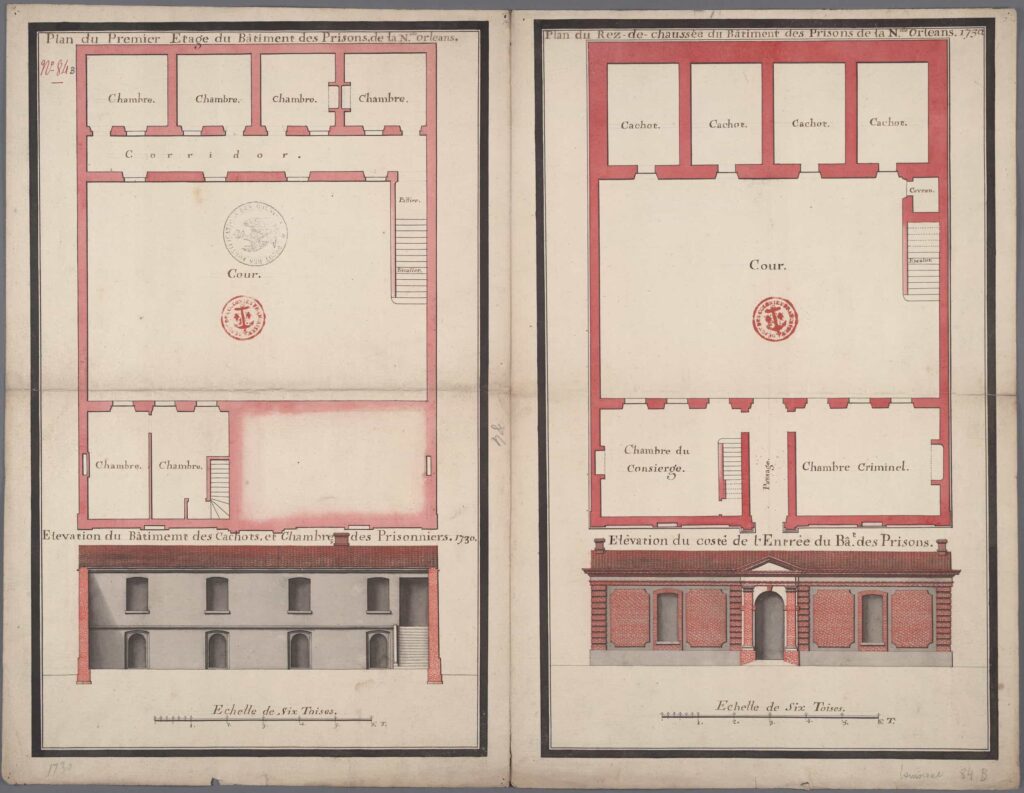
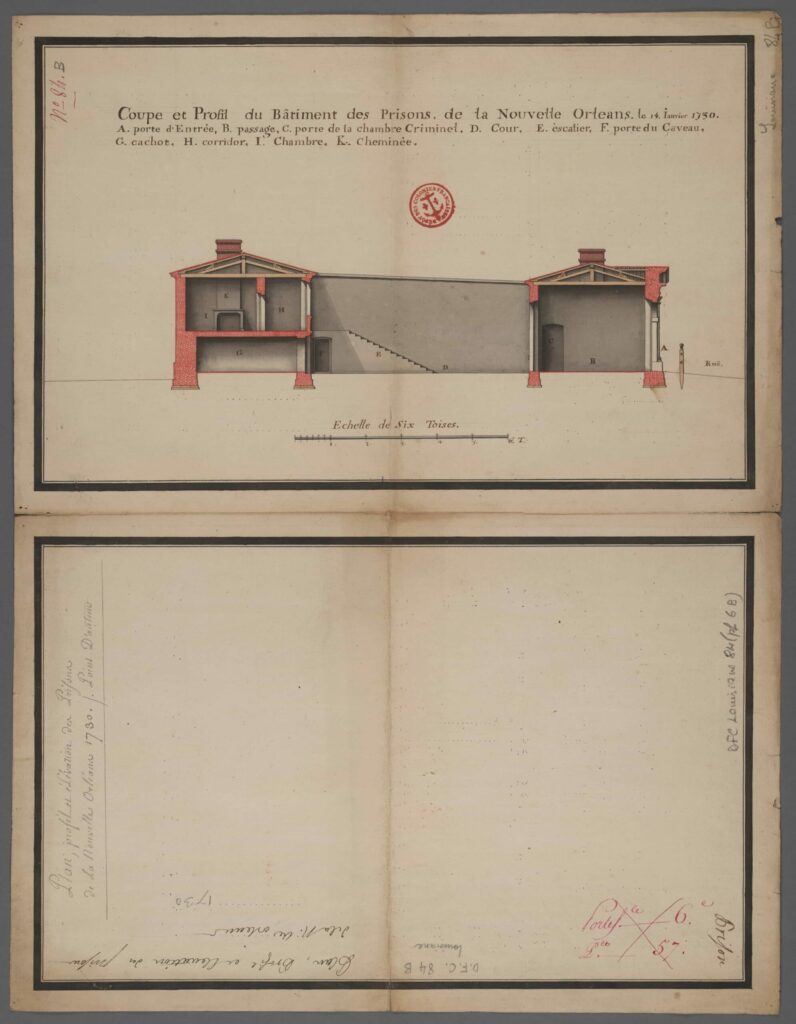
Figures 3A and 3B
Anonymous, Plan, profil, et elevation des prisons de la Nouvelle Orleans, 14 Janvier 1730. Watercolor. FR ANOM 04 DFC 84 B. Courtesy Les archives nationales d’outre-mer. Aix-en-Provence, France
The top view is of the prison from rue d’Orleans; the entrance faced the church. It shows the rear building (accessed from the inner courtyard) and the floorplan of the upper level. The bottom view shows the prison from the perspective of rue de Chartre (present-day Chartres Street). The bottom view shows the front building and entrance from the street and includes the floorplan of the ground level. The walled-in courtyard measured approximately thirty-eight by fifty-one feet. Each cell (on the upper level) measured about sixteen by twelve-and-a-half feet, meaning that these were communal cells. The criminal chamber was where interrogations on the sellette and judicial torture were carried out; it measured approximately nineteen by twenty-five feet.
Judicial Torture: La question
Judicial TortureJudicial torture was used sparingly on the enslaved in French colonial Louisiana. The court had their own reasons for this. In the Illinois Country in 1725, for instance, the enslaved man Perico was convicted of theft, but local authorities sought permission to whip him over several days instead of enforcing his sentence of judicial torture. They explained this in terms of the Company of the Indies’ “pressing” need for slave labor, the assumption being that a body that had been whipped was in better condition for labor than one that had been subjected to judicial torture. The same reasoning can be assumed for the generally low rate of judicial torture in a colony, which, with few exceptions, did not see the arrival of slave ships (and new enslaved bodies) after 1731. There was an exception to this general rule between 1763 and 1765, during a short-lived law-and-order campaign that occurred at a moment of crisis for the planter class, as they confronted France’s cession of Louisiana to Britain and Spain. The event led to the only time during the French regime when judicial torture was applied systematically, and almost exclusively, to the enslaved.16
Judicial torture came in two variants that were carefully outlined in the 1670 Code criminel. The question préparatoire was reserved for capital offenses where guilt was inferred but there was insufficient proof to convict. Since it was intended to elicit a confession, it was applied prior to final sentencing. The question préalable was reserved for those already convicted of a capital offense but whose testimony under torture might elicit evidence against accomplices. Either way, there was a presumption that an accused person sentenced to judicial torture was guilty but that the evidence was short of full proof.17
If judicial torture was decreed, the law mandated three interrogations, before, during, and after torture. The final interrogation, or “interrogation on the mattress,” was conducted after the accused was released from torture and laid onto a mattress. If he or she had confessed under torture, then the confession had to be reiterated on the mattress in order to be binding (and incur the death penalty). If not, only afflictive penalties, in other words those that caused corporal pain, could be handed down.18
To inflict judicial torture was a specialized profession and a stigmatized one that made recruitment for the job difficult. In Louisiana, beginning in 1725, that role fell to a former slave, Louis Congo, who negotiated his manumission along with that of the woman he wished to marry, as a condition of becoming executioner. The standard method of torture in Louisiana was the use of the leg brace (le brodequin). Another accepted method, water boarding (la question de l’eau avec extension), does not appear to have been used in the colony. The leg brace entailed having the defendant sit on the sellette while four planks of wood were placed on the inside and outside of each leg, from the feet to above the knees. The executioner secured the planks “by ropes passed through holes at their ends, and the ropes were then wound tightly around the planks to form a casing for both legs.” Pain was inflicted and controlled by means of wooden wedges that were hammered inside the planks from the knees down to the ankles. Each wedge increased the pressure. For the “ordinary question,” four wedges were applied; for the “extraordinary question,” eight. After each wedge was driven in, the judges posed questions concerning the crime and the culpability of the defendant until the interrogation was deemed complete. Though the brodequin did not physically injure or permanently mutilate the accused, the pain and sensation it produced was especially acute, akin to having limbs broken.19
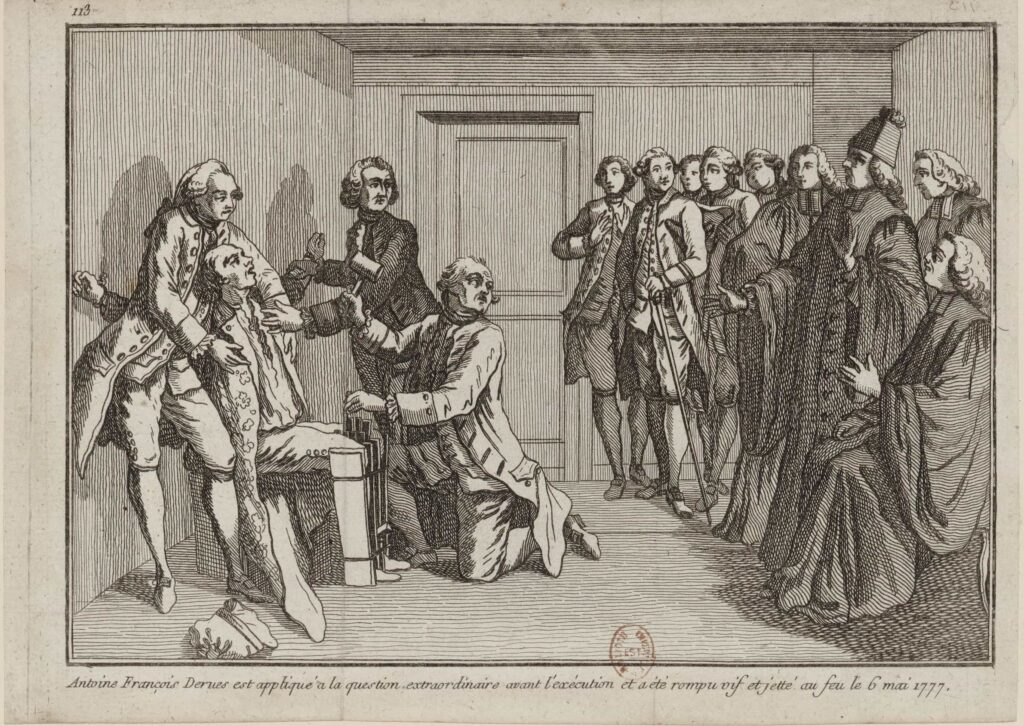
Figure 4
Unknown. Antoine François Derues est appliqué à la question extraordinaire avant l’exécution et a été rompu vif et jetté au feu le 6 mai 1777. From Portrait de Desrues et quarante planches relatives à la vie, aux crimes et à l’exécution de ce scélérat. 1777. Engraving. Département Estampes et photographie. RESERVE QB-201 (110)-FOL. Courtesy Bibliothèque nationale de France. Paris
In this engraving from a set about an infamous French court case, the accused is shown undergoing judicial torture using the method known as the brodequin.
Extrajudicial Violence
Extrajudicial ViolenceProsecutions were just one means of rendering and seeking justice. The court system was not the only mechanism for identifying and chastising slaves, and the trial records are sprinkled with references to extrajudicial punishments or unofficial bargaining over perceived wrongdoings. Such evidence comes to the fore, for example, through references to masters policing their slaves’ conduct and imposing corporal punishment. Extensive evidence also exists of the enslaved contesting this regime of violence by preemptively entering into negotiations with their masters (often via intermediaries) to secure their pardon and a lighter punishment by deploying gestures of contrition and submissiveness in a carefully honed performance between slave, master, and mediator.
Notwithstanding Article 38 of the 1724 code noir, which prohibited masters from “torturing their slaves or mutilating any limb, under any pretense whatsoever,” no master was ever prosecuted in Louisiana for abusing his or her slaves. The code noir, however, was ambivalent at best in such cases. The next article prescribed the criminal prosecution of masters suspected of killing or mutilating their own slaves and mandated they be punished “according to the atrocity of the circumstances.” Yet it allowed that masters and overseers could, in some circumstances, be absolved of guilt and pardoned. In practice, therefore, masters enjoyed vast latitude and protections when they sought to investigate, question, or punish their own slaves. If it is not surprising that masters took advantage of this laxity, it is still jarring to see not only how endemic extrajudicial violence and investigations were but also how frequently they are alluded to in passing in court testimony.20
The presumption has to be that, most of the time, owners routinely disciplined their own slaves informally and independently of the court system and that criminal trials were just one rather exceptional mechanism for controlling, subjugating, and punishing the enslaved. The irony is not lost that it is in trial records that the enslaved offer glimpses of the pervasiveness of a range of extrajudicial surveillance, prosecution, and corporal punishment (see the trial of Jannot) that is not documented elsewhere.
Familiarity with West and West Central African laws could have also influenced how deponents responded under questioning in Louisiana, especially for those born in Africa. Questioning and divining rituals as well as sentences for punishing activities deemed either criminal, immoral, or dangerous to society (such as that shown in Figure 5) might have differed in format, but they were not entirely alien from the investigations, interrogations, and inquisitorial foundations of French colonial courts.21

Figure 5
Unknown Capuchin artist. Experiment to Expose the Thieves; or, Really Another Type of Oath . . . 1: Thief 2: Fire 3: Iron Made Red-Hot 4: Enchanter. The Parma Watercolors. PW087. Virgili Collection (Bilioteca Estense Universitaria), Italy. Photo: Cécile Fromont.
In this watercolor produced in the Kongo by an unknown Capuchin missionary, the artist has included the explanation: “someone being accused of theft a certain minister of the Devil called Nbaù makes an iron red-hot and puts it on one of the legs, if it burns [the person] is convicted and condemned If it does not burn he remains free.”
Violence was not restricted to punishments but was integral to the brutality of a labor system in which an enslaved man like Jupiter dit Gamelle “was shouted at, threatened and sometimes abused” (Grondé Et Menacé Et quelques fois Maltraité) when he did not produce enough for his master. Scattered throughout the trials, is evidence of endemic violence of the most intimate kind—up close and personal, commonplace, mentally and physically coercive, and invasive. The legal justice system shared some of these features.22
Sentences and Penalties
Sentences and PenaltiesThere was one arena in which the enslaved did not have the opportunity to speak before the court, and that was at the point of sentencing and punishment. Once all interrogations had taken place, the judges deliberated and pronounced their verdict. As a rule, sentencing of the enslaved was consistent with the law, fitting one of the nine levels (and twenty-five subgroups) of punishments itemized in the 1670 Code criminel, including the death penalty. In France, outside the military, afflictive punishments incorporating mutilation of the body were rarely imposed by the late seventeenth century. Not coincidentally, in France’s colonies, convicted slaves bore the brunt of afflictive punishments.
As outlined in Articles 27–32 of the 1724 code noir, whipping and branding with the fleur-de-lis were mandated in convictions for theft, but the death penalty could be imposed for serious thefts. Running away for longer than one month incurred a sentence of having the ears cut and branding on the shoulder, second recidivism meant having the hamstring cut and branding on the other shoulder, and third recidivism resulted in the death penalty. Capital punishment was also prescribed when a slave struck his or her owner or a member of their owner’s family. The Superior Council decreed sentences and sometimes commuted them. One unquestioned benefit for a colonial society of the court reducing or commuting the death penalty was that the accused lived another day to labor as a slave.23
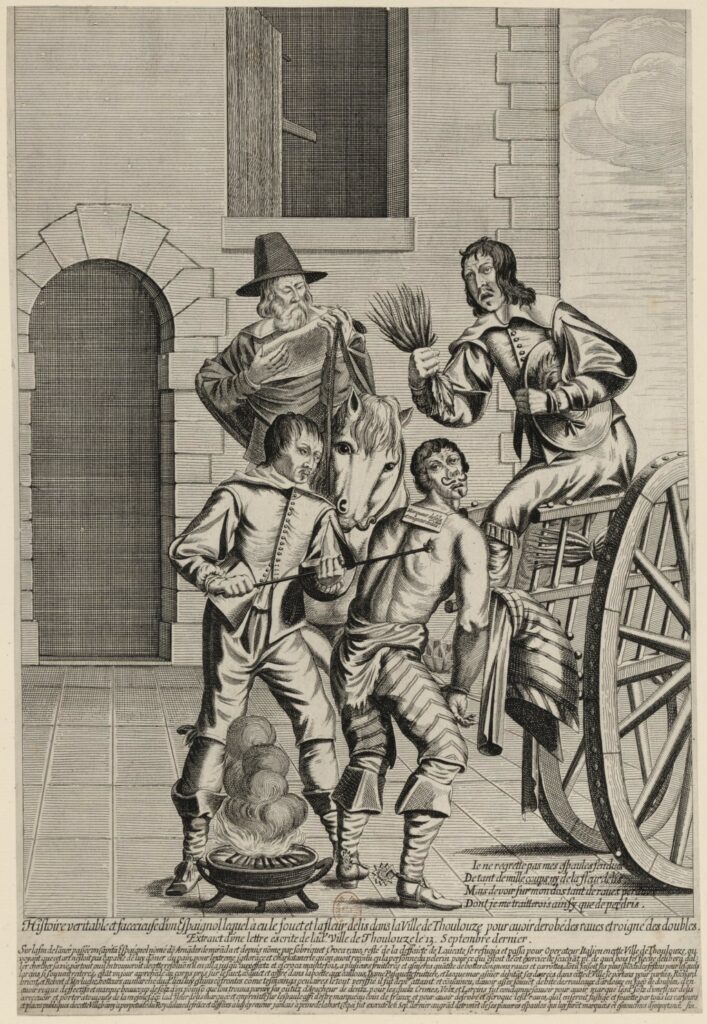
Figure 6
Histoire veritable et facecieuse d’un Espaignol lequel à eu le fouet et la fleur de lis dans la ville de Thoulouze pour avoir derobé des raves et roigné des doubles . . . 1630. Richelieu. Département Estampes et photographie. RESERVE QB-201 (27)-FOL <p.24>. Courtesy Bibliothèque nationale de France, Paris
In this rare depiction of a judicial branding, we see a hot iron shaped like a fleur-de-lis being applied to the right shoulder of a convicted criminal in 1630 France.
Conclusion
Court transcripts were selective soundscapes. Although they aimed to constitute a true and accurate record of words spoken, specifically in the back and forth between questions and answers, they were not records of the whole performance of justice. They did not seek to capture every element of a trial or every feature of testimony. Nor did they record defendants’ reactions to judgments, such as whether or not they sat in stony silence, gasped, cried tears, or hurled insults when their sentence was pronounced. Nor did trial records make note of whether the accused begged forgiveness. Finally, transcripts in Louisiana did not include the agonizing sounds of convicted felons being put to death nor did they make note of the noises produced during judicial torture: the creaking sound of the leg brace as it was cranked more and more tightly during the hour or so that the ordeal lasted or the victim’s cries of pain. Court records omitted these sounds of suffering, just as they were devoid of deponents’ gestures, looks, mannerisms, facial expressions, accents, and intonation during their testimonies. These, too, were components of the performative aspects of court procedure, a performance shaped by words, by sound, by the spatial environment, by sartorial conventions, by gestures, and by the rituals of the court. What testimony does offer is access to the words of the enslaved, allowing the biographies of enslaved individuals to be uncovered virtually as they themselves narrated them.










